#e library project documentation
Text
DESIGN AND IMPLEMENTATION OF AN ONLINE LIBRARY SYSTEM
DESIGN AND IMPLEMENTATION OF AN ONLINE LIBRARY SYSTEM
DESIGN AND IMPLEMENTATION OF AN ONLINE LIBRARY SYSTEM
CHAPTER ONE
INTRODUCTION
1.1 LIBRARY SYSTEM
A library can be defined as a room or building where books are kept and referenced. It is an area of multifarious activity on book management. A library as a repository of knowledge, houses collections of books, both reference and general, technical reports, periodicals, journals, conference…
View On WordPress
#design and implementation of a digital library system pdf#design and implementation of an online library management system#DESIGN AND IMPLEMENTATION OF AN ONLINE LIBRARY SYSTEM#e library project documentation#e library project in php#e library project pdf#e library project proposal pdf#how to create a design matrix#how to create an online library#how to create an online library catalog#how to implement a design system#how to make online library management system#how to manage e library#literature review on online library management system#online library management system project report pdf#ONLINE LIBRARY SYSTEM PROJECT TOPICS#what is included in a design system#what is online library management system#what is system design and implementation
2 notes
·
View notes
Text
Hey folks, just dropping some resources here for those of you who, like me, are always on the hunt for free reading material, whether it's for research or just to satisfy your curiosity. If you're always looking to expand your reading list without breaking the bank, check these out:
Library of Congress: Absolute goldmine for academic researches and historical documents. You can spend hours diving into their collections.
Z-library: A treasure trove of books, articles, and papers on pretty much any topic you can think of. Quick downloads, no fuss.
Project Gutenberg: Free e-books galore, especially if you're into classics. Saved me from many a boring commute.
Internet Archive: A digital library offering free universal access to books, movies, and music, plus archived web pages. Endless hours of browsing joy.
Google Books: Sometimes you just need a quick peek inside a book without committing to buying it. Google Books has got your back.
Google Scholar: It scours through scholarly sources, journals, theses, and more. Just be ready to sift through some dense material.
JSTOR: Another heavyweight in the academic world. JSTOR is packed with scholarly articles, books, and primary sources across various disciplines. Some stuff may be behind a paywall, but there's still plenty to explore for free.
Newspaper Archive: Want to browse through historical newspapers? This site has a massive collection spanning centuries and covering a wide range of topics. Perfect for digging up primary sources.
Newspapers.com: Need more historical newspapers? Look no further.
Perseus Digital Library: Focuses on ancient Greco-Roman materials, perfect for those deep dives into classical history.
Digital Public Library of America: Another treasure trove of digitized materials, including photos, manuscripts, and more.
Europeana: European cultural heritage online. Images, texts, the whole shebang.
DOAJ: Open access journals. DOAJ indexes and provides access to high-quality, peer-reviewed open access research journals.
Open Library: Another digital library offering over 1.7 million free eBooks.
Librivox: Audiobooks for when your eyes need a break.
National Archives (UK): Offers access to a wealth of historical documents, including government records, maps, photographs, and more.
Sci-Hub: For the rebels. Access to scholarly articles.
Directory of Open Access Books (DOAB): Looking for free scholarly books? DOAB has got you covered with a vast collection.
Digital Commons Network: Free, full-text scholarly articles from hundreds of universities and colleges worldwide.
Directory of Open Access Repositories (OpenDOAR): Find open access repositories worldwide.
Gallica (Bibliothèque nationale de France): French flair for your research.
DigitalNZ: Your gateway to New Zealand's digital heritage.
#college life#study#resources#history nerd#anthropology#online learning#academic life#ResearchResources#DigitalArchives#free books#free#digital#archives#libraries#academic#research#books
109 notes
·
View notes
Text

Miguel O'Hara is a world-renowned professional boxer, and Hobie's other best friend. One night he finally makes the two worlds collide and sparks immediately fly between the two of you. But will he distract you from meeting your publisher's deadline? And will you distract him from getting World Champ?
before you follow. m.list. Iron Fist gfx library. series m.list. tag list.
Prologue. I. II. III. IV. V. VI. VII. VIII. IX. X. Epilogue.
wc. 1.5k
an. hi. its me! Giselle, or gi, or gigi to few (not to be confused w gg, that is one of my moots. she makes really cool art.) n e ways here is the awaited Prologue for Iron Fist. Oh goodness I'm so nervous. I just want to make a few things clear. the reader is an author (obvs). She's recently graduated uni and is Latina! I write with a woc!r in mind always. I try to be as inclusive as possible, pero porque soy Mexicana, r might lean towards being more Mexican but I'll try to keep her Spanish standard and not be too specific to my family's culture. much love! hope you enjoy <3
please don't forget to reblog! likes do nothing to boost engagement.
Your foot taps against the floor. The damn blank document stares back at you. Mocking you is what it’s really doing. Fuck you, you think, I achieved my goal. I published a book and it is a damn bestseller! Only problem is that the readers want more. It’s been… some time since your first book. And sure, Jess said you can take a break before starting a new project. But you also know that it’s good to ride on existing publicity. At least be able to make an announcement that you’re writing something while all this excitement lasts. Maybe you should write something about vampires. You love vampires and how they fit into romance and how them drinking blood is a euphemism just a bit away from, the whole cannibalism-equals-all-consuming-love trope and how when a vampire attacks it’s often an allegory for rape and— but you have nothing to add to the conversation. You have nothing new to say, no new perspective or hot take, or twist. You have nothing. No ideas.
Not a single word on the page.
You have an idea, leaning forward to peck the keyboard.
“F-u-c-k. T-h-i-s!” You highlight the text and italicize it.
Fuck this. At least it’s words on the page.
You reach for your cup and take a sip. “If all else fails I can ride on the rest of the signing bonus and royalties for a bit since the book is doing good, and once that dries up, I can apply to be circulation assistant at a library or something.” You sigh and take another sip. “But nobody has to know for now.” You get up, searching for your phone. You find it resting on the arm of the couch, you grab it, sliding onto the cushions, resting your head where your phone just was. “God, don’t make me a one hit wonder, I wanna be a star. I wanna be the one to push that bitch Colleen Hoover into obsoletion. Please God. Please.”
You open your phone and look for your mother on speed dial.
“Hola, nena!” Your mama’s voice is happy, she must be having a good day. You move into the kitchen. You need a snack.
“Hey, mama, how are you?” You hold the cell with your shoulder as you look through your pantry.
“Good, good,” you find a pack of roasted seaweed snacks and grab it.
“I went on a date anoche.” Your shoulder drops and the pack of seaweed slips out of your grasp.
Mi mami fue a una cita. Con un man! You stand there, trying to process that she is actually back on the dating scene.
“How did it—” you aren’t holding your phone anymore. You use the wall as support to lower yourself to pick up your phone and snack.
“—ay, mami, lo siento, mi cellular se cayo de mi mano.”
“Todo bien, hija! I’m glad you’re ok.”
“Yeah, yeah, I’m ok, I’m ok. Anyways— how was the date? What’s he like? Am I going to have a stepfather soon?” you joke.
“My time for marriage is gone, muñeca, I’m just looking for companionship, pero, tu lo sabes.” You hear some subtle clinking in the background of the call, she must be stirring her coffee. You open your snack and park yourself on the couch. “Are you writing?”
Ugh. Not you, too.
“I was, just finished for a bit before I called you.”
“You called me to procrastinate.” You choke on your seaweed from the accusation.
You clear your throat, “I called to check in with you. I call you practically every day.”
“But right now you called me to check up on me as an excuse to not write. Nena, I know you.”
“Okay, fine. I might be having some writer’s block,” you admit, sighing.
“And that’s okay, nena, but then you need to get out, get some inspiration. Allow the world to give you a story.” There’s mama, with her easier-said-than-done advice. But, maybe you should get out of the house.
“Alright, I’ll go out soon.”
“Tonight,”
“—I will go out to the Chinese place across the street and nothing more. I’ll talk with Hobie when he gets back to see if he has any ideas.” You hear your mama make a noise in her throat.
“You still live with that boy?” Here it comes. You’ve lived with Hobie Brown for three years and have known him for five. She’s always been apprehensive of him, since he’s radical and looks like he’s been in jail, with all the metal in his face, and why does his hair look like that? But Hobie is the one who’s kept you sane all these years. He’s held you while you cried and pushed out of your comfort zone when you were getting too stuck into your routines, most likely by dragging you to a concert or a protest. You help him thrift and flip clothes and ever since that one time his stylist had an emergency and canceled, you now help him tighten his wicks every so often. On days like that the two of you stay in, watching nostalgic movies and listening to any demos he’s recorded recently. He’s like a brother to you at this point.
“Yes, mama, I still live with Hobie. Nothing’s changed.” You move the phone down to your chest and take a deep breath.
“I didn’t like him when I first met him,” you clench your jaw as she continues— “…and although he’s one of those kids, I can tell he is a good boy. I’m glad he takes care of you.” You relax. “But it wouldn’t hurt to have someone you could kiss.”
“It would be nice, but right now it’s not happening.”
“Alright, muñeca. I’ll leave you alone for now, but keep your eyes open for a nice man.”
“I will, con cuidado, mami, besitos.” You make a kissing noise into the phone, and she responds with a goodbye of her own, and you wait for her to hang up the call.
You sigh, and look at the coffee table. Hobie left his song book at home, weird. It’s open to the song he was working on the other day. It’s a slower song, you can still hear the melody. You drum your fingers to the tune. He’s on an unfinished verse. You pick up a pen from the little catch-all dish and scribble down a line or two.
…
Hobie weaves through the roar of chattering, anticipating fans and into the tunnel, and walks past employees and into Miguel's prep room to see him tying his shoes. “Hey,”
Miguel looks up. “Hey.”
“Are you excited?” He moves to sit by the boxer, shimmying up against his shoulder.
“Haven’t really been excited for one of these in a while.” Miguel breathes.
“Well, one step closer to retirement!” Hobie bounces out of his seat. He turns to face his friend, putting a hand on his shoulder. “You’re gonna do great, you big fuckin’ bear of a man.” He ruffle’s Miguel’s hair.
Miguel gives a half-ass hum in response.
“Well then, I’ll be out there, mate, cheerin’ you on.” He puts his hands in his vest pockets and walks out the room.
As he reaches the empty doorframe, Miguel speaks up. “Thank you, Hobie.”
“Anything for you, mate.” Hobie nods and goes to join the audience.
Miguel fastens his gloves and puts on his robe. He warms up waiting for his coach.
“Ready, O’Hara?”
Miguel turns around. “Always ready for a fight.” He clenches his jaw.
Walking down that hallway, the festive colors lighting up his path and the music blaring, he does his little bit, the movements molded into muscle memory.
This is it. This is his last year fighting. If he gets world champ again, he’s free.
Soon, he gets to fight his last fight. And dammit, the world championship will be his last match. Then, he’s never gonna have to come back.
He weaves under the ropes, entering the ring.
Sitting on the stool, he shrugs off the robe and lets Carlos put the mouthguard in.
“You are going to show this guy exactly why people call you el oso!”
Miguel beats his gloves together and nods. He might not like his job right now, but he really wants to hit something and goddammit if his opponent doesn’t look so beatable right now.
Coach Carlos steps out of the way, and Miguel stands to walk to the ref as he calls for him to center.
“We went over the rules in the dressing room.” Right before Hobie got here. “I want to remind you to protect yourself at all times, and obey my commands.” Ring the damn bell already. “God bless you both,” I don’t need it but this kid might. “Touch up,” here we go. He touches gloves with his newbie opponent and each goes back to their respective corners.
Miguel takes an orthodox stance.
The bell rings.
Miguel lands the first punch. He also lands the last.
#Iron Fist 🥊#my writing#boxer!miguel o'hara#boxer!miguel#atsv miguel#miguel o'hara#miguel o'hara x reader#miguel o’hara x reader#miguel o'hara x fem!reader#boxer!miguel x author!reader#miguel o'hara x you#across the spiderverse#spiderman atsv#spiderverse#atsv#atsv x reader#atsv x fem!reader#atsv x you#age gap relationship#miguel my love
120 notes
·
View notes
Text
Some tangible Black queer history for you!
In case you needed any more proof that we've always been here - this amazing collection is courtesy of the Stonewall National Musuem and Archive!
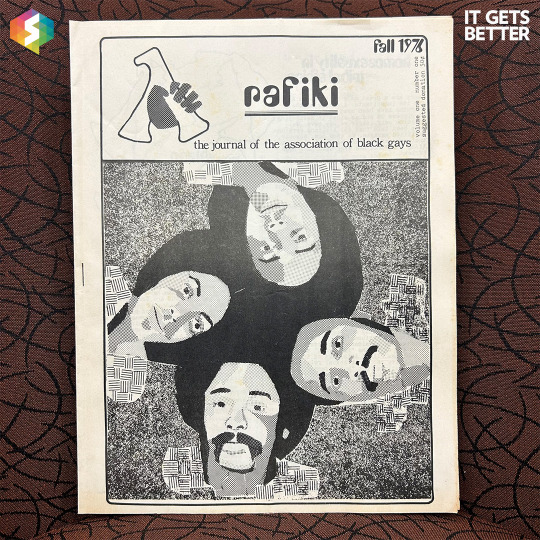
Rafiki: The Journal of the Association of Black Gays, Vol. 1 #1 (Fall 1976)
"Rafiki was a quarterly publication from the Association of Black Gays (ABG), a Los Angeles, California gay activist group that organized through education, political engagement, and grassroots activism to
improve the conditions for Los Angeles’s Black gays and lesbians.
According to the journal, the title Rafiki was chosen because it means “friend” in Swahili and “that’s what [ABG] hope to be for you.” This first issue includes an article on the history of ABG and the fact that Black gays and lesbians have been largely excluded from the political, social, and economic advances of the gay community.
Included in this issue are articles such as “Homosexuality in Tribal Africa” and “Disco Discontent” (an open letter to the owner of Studio One, Scott Forbes), as well as poetry by Steven Corbin and Frances Andrews, and book reviews. It even contains an ad for the famous Catch One Club owned by Jewel Williams, which is still
operating today!"

I Am Your Sister: Black Women Organizing Across Sexualities by Audre Lorde (Kitchen Table: Women of Color Press, 1985; from the Freedom Organizing Series)
You can read this one here!
"This small twelve-page publication derives from a speech Audre Lorde gave at the Women’s Center of Medgar Evers College in New York City regarding the exclusion of Lesbians in the feminist movement and how Lorde’s identity as both a Black woman and lesbian are inextricably linked.
Primarily, heterosexism and homophobia are major issues Lorde states are “two grave barriers to organizing among Black women.” Lorde ends the essay with the statement: “I am a Black Lesbian, and I am your sister.”
Her emphasis on the duality of this identity stems from a 1960s poster that said “He’s not black, he’s my brother!,” which Lorde states infuriated her because “it implied that the two were mutually
exclusive.”
Kitchen Table: Women of Color Press was founded by Barbara Smith—another Black Lesbian feminist—and Audre Lorde in 1980 to create a publishing apparatus for women of color who at the time did not have control over how they were published except through the white-dominated outlets."

Flawless! The Life & Times of T.B.D.J. AKA Tiffani Inc. AKA Mrs. … (Manuscript) by Tiffany Bowerman (July 2007, A&E Publishers)
This autobiographical manuscript traces the life of Tiffany Bowerman aka Tiffany B.D. Johnson (b. 1959), who states that she “was the first African-American Transsexual to have state issued birth certificate reissued [1990]… was the first to legally marry three different active duty military men… [and] first… to found their own Christian Denomination… The Agape-Ecumenical Christian Denomination.”
Further, she states “I have tried to put together something striking and original[,] a journey from childhood to self aware adult. A life that was and is with all regrets included.”
This manuscript is a preliminary copy of a rough draft, and contains various memoirs, photographs, legal documents, and ephemera.
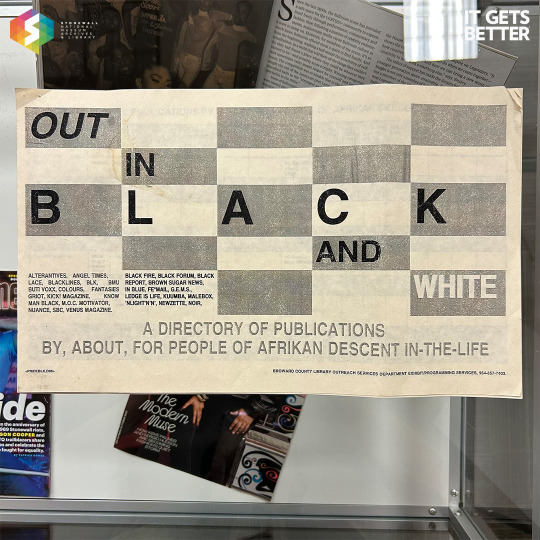
Out in Black and White: A Directory of Publications By, About, For People of Afrikan Descent In-The-Life by the Broward County Library Outreach Services Department Exhibit/Programming Services with direction by Eric Jon Rawlins (January, 1996)
Out in Black and White is a directory of various serial publications (magazines, newsletters, journals, etc.) throughout the United States that are focused on the Black LGBTQ experience. According to the directory, “[t]his project was inspired by the atmosphere of strength, oneness and productivity created by the Million Man March [on October 16,] 1995.”
The Million Man March was a political demonstration that took place at the National Mall in Washington, D.C. with the purpose of encouraging involvement in the improvement of the conditions of African Americans. Eric Jon Rawlins was a Broward County, Florida librarian who at one time was also the second vice president of the NAACP Fort Lauderdale branch in the late 1980s.
Currently, the Eric Jon Rawlins Collection consisting of personal and professional papers, as well as his 6,000 vinyl record album collection, are housed at the African American Research Library and Cultural Center Special Collections in Broward County, FL.
#it gets better#black history month#bhm#black trans lives matter#lgbtqia#queer history#lgbtq history#black history#queer archive#queer lit#studyblr
106 notes
·
View notes
Text
Checklist For Writing Essay:
Masterlist
BUY ME A COFFEE
More of a person note for me, when polishing off an essay to double check the criteria.
Times New Roman
Size 12
10% of word count over if needed.
Italicize works of art.
“_” for chapters/books.
Name of Artwork, Artist name, Date, Size, Location
Try to find images of the work with people/in the gallery space.
Spell out any number below 100 (eg. Three dimensional)
Double Spaced
(Not cheating to share your work with someone on the course and discuss)
Must use Footnotes, MHRA refrencing style
Footnotes sometimes count in word count DOUBLE CHECK
Footnote numbers should always appear after the full stop at the end of the relevant sentence, even when they refer to a point made
midsentence.
When writing visual analysis, consider closing your eyes as someone reads back what you’ve written about the artwork, and consider if you can clearly visualise in your mind from what you’ve written.
Paragraph organisation by: Intro/ paragraphs on separate ideas/ conclusion
Online walkthrough gallery. Make arguments/convince when writing, of what you see/ how you understand it.
Talk about materials used.
Space it inhabits and effect on observer.
Academic sources must be used.
Short comings in the essay/academic paper to be discussed and evaluated.
JSTOR
Website and access to academic papers usually needed to have uni library sign in. Some museums have sources too. Browse library or articles in library database.
Find interesting texts, then use and write about it. Footnotes included in work count.
Museum repository, Wikipedia to start.
WHAT IS MOST SIGNIFICANT TO YOU?
ADDITIONAL RESOURCES:
London Metropolitan Archives picture library, aka 'Collage' - all things London
London Metropolitan Archives youtube channel
BFI Player film archive - shorts and features from the BFI, national and regional archives
BFI Player - Britain on Film, with searchable map
RibaPix - UK's largest architectural photo library
Pathe Newsreel - great way of quickly diving into historical news items, and fascinating for the visuals as well as the thorough textual transcripts
British Cartoon Archive - 200,000 British editorial, socio-political, and pocket cartoons covering 200 years
Black in the Day - A submission based archive documenting the lives of black people living in the UK
Wellcome Library - not all but many items are digitised
For those students with a particular interest in museums and museum studies, check out our very own Mapping Museums website:
https://museweb.dcs.bbk.ac.uk/home
Researching Online: A Guide
Below are worked examples of how to do an essay or research project using only online resources.
Don’t spend ages looking for one article or book unless it is really essential and even then, you may not be able to get it, but you will find something related.
Vary your search terms, e.g. for the examples below: early modern, renaissance, reformation, sixteenth century might all be relevant.
Follow links in articles and on collections – often, footnotes in journals online may be hyperlinked to the item (especially in more recent publications), you can see similar items, or who has cited that work. For primary sources/collections, catalogues may suggest similar items too.
There will be dead ends and frustrations but persevere – there is lots of material out there.
Save things using a citation programme like Zotero or Mendeley
If you find something interesting and potentially useful for another topic, bank it for later
Be creative and use sources you might not have thought about before, for example the sound archive in the British Library and think across period and geography.
Google Scholar and on JSTOR/other platforms, Project Muse
which is another very good platform with loads of open access material.
USTC: the USTC is a database of early modern printed books across Europe
Interesting source:
#art gallery#writing#essay#paintings#art tag#art exhibition#art show#artwork#art#art hitory#essay writing#history#historical#artists#artists on tumblr#drawings#illustration#art style#writers#creative writing#writers on tumblr#writeblr#writers and poets#lecture#art history#photography#antiques#sculptor#sculpture#screen printing
17 notes
·
View notes
Text

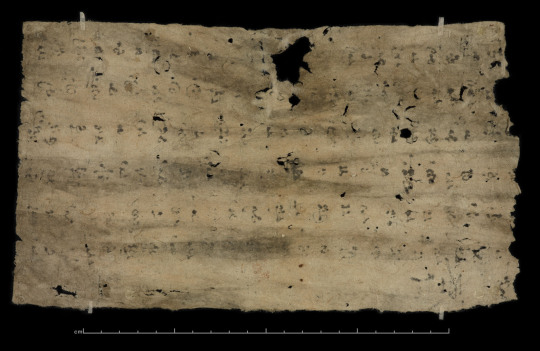
Saka Scythian Khotanese document Or.6394/2 from Dandan Uiliq, 778-779 CE. The British Library.
From the International Dunhuang Project:
"Order from the spāta Ṣṣanīraka to the haṃdasta Sīḍaka in Gaysāta regarding payment. The similar document SI P 103.40 mentions the year of the ṣṣau Ṣacū (= 778-9), and SI P 103.41 mentions a *Sogdian (sūlī). Hoernle, 1901, p. 38.
Translation:
(1) The spāta Ṣṣanīraka orders thus: To the haṃdasta Sīḍaka in Gaysāta:
(2) Thus you owe x mūrās per head as well as those for cloth for winter clothes.
(3) And those mūrās they requested in the month of Kaja in the Inner Fortress. And I requested them from the *Sogdian
(4) with interest. Now, the *Sogdian has come here. When you hear the order bring here those 9,370 mūrās
(5) with the interest. The *Sogdian is not going to you. If you do not bring those mūrās here within five days [note a: Cf. SI P 103.42 paṃjvā haḍvā ma thaṃgä ājimyari “bring the tax here within five days!” ]
(6) you will have to eat (= suffer) strong penalties. [note b: Chin. phau, see Intro. Cf. SI P 93.5 [paʾ]jsa phauʾva byehi, SI P 94.4 X[...] ājume phauʾ-v-e parī hauḍä.]. On the 6th day of Haṃdyaja the order
(7) went out to you."
#scythian#ancient history#history#museums#artifacts#antiquities#archaeology#xinjiang#khotan#sogdiana
13 notes
·
View notes
Text
What to Expect from a Mobile App Development Platform: Navigating the Scottsdale Tech Oasis

Sunsational skies, vibrant cacti, and the heart of Arizona’s booming tech scene – Scottsdale, Arizona, isn’t just a desert jewel; it’s a launchpad for your mobile app aspirations. But with a plethora of Mobile App Development platforms vying for your attention, navigating the tech oasis can feel like scaling Camelback Mountain without a Camel. Fear not, intrepid apppreneurs! This guide will equip you with the knowledge to choose the perfect platform and transform your Scottsdale dream into a pocket-sized reality.
So, what exactly is a Mobile App Development Platform?
Imagine a one-stop shop for your app creation journey. A platform that not only provides the tools to build your app but also guides you through every step, from initial brainstorming to sparkling app store debut. That’s the magic of a mobile app development platform – a Scottsdale sherpa leading you through the tech terrain.
What should you expect from your Scottsdale app development platform?
1. A Symphony of Tools:
Drag-and-drop simplicity: Forget mountains of code; platforms like Thunkable or Appy Pie let you visually design your app using intuitive drag-and-drop interfaces. Think building blocks for your app, minus the construction dust.
Pre-built functionalities: No need to reinvent the wheel. Platforms offer a library of pre-built features like maps, social media integrations, and e-commerce modules, saving you time and resources.
Native app magic: Some platforms like BuildFire and AppSheet specialize in generating native apps for both iOS and Android, ensuring your app feels at home on any device.
2. A Budget-Friendly Oasis:
Let’s face it, budgets matter. Scottsdale platforms like GoodBarber and Adalo offer affordable subscription plans to suit your pocket, making app development accessible even for bootstrapping startups.
3. No Coding Required (Maybe):
Worried about coding jargon and cryptic syntax? Some platforms cater to non-technical users, allowing you to build basic apps without writing a single line of code. However, learning basic coding skills can unlock greater customization and flexibility in the long run.
4. A Knowledge Oasis:
Learning resources, tutorials, and helpful communities are your desert guides. Platforms often provide extensive documentation, video tutorials, and even active forums where you can connect with fellow app creators and seek advice.
5. Beyond the Build:
The journey doesn’t end at launch. Platforms offer app analytics tools to track user engagement, identify improvement areas, and optimize your app for success. Think of it as your personal Scottsdale app performance tracker.
Affordable Mobile App Development Company in Scottsdale:
Now, let’s address the elephant in the room – cost. While platforms offer budget-friendly solutions, remember, app development services from an experienced company like Net-Craft.com can provide invaluable expertise and customization, especially for complex projects. We offer bespoke app development solutions, catering to your specific needs and ensuring your app stands out from the crowd.
Choosing the Right Platform:
There’s no one-size-fits-all platform. Consider your technical skills, budget, app complexity, and desired functionalities when making your choice. Research, compare features, and even try out free trials to find the platform that resonates with your Scottsdale app vision.
Remember:
Mobile app development is a journey. Enjoy the process, embrace the learning curve, and don’t be afraid to ask for help.
Scottsdale’s tech scene is thriving. Network with other app creators, attend workshops, and tap into the collective Scottsdale tech spirit.
Net-Craft.com is your Scottsdale app development partner. Whether you choose a platform or seek our expertise, we’re here to guide you, every step of the way.
With the right tools, the right mindset, and the right Scottsdale partner, your mobile app dream can blossom from desert seed to Silicon Valley success. So, grab your metaphorical hat and sunscreen, and let’s embark on this exhilarating app development adventure together!
Content Source https://www.net-craft.com/blog/2024/01/29/what-to-expect-from-a-mobile-app-development-platform-navigating-the-scottsdale-tech-oasis/
2 notes
·
View notes
Text
The "National Emergency Library" & Hachette v. Internet Archive
While the Internet Archive is known as the creator and host of the Wayback Machine and many other internet and digital media preservation projects, the IA collection in question in Hachette v. Internet Archive is their Open Library. The Open Library has been digitizing books since as early as 2005, and in early 2011, began to include and distribute copyrighted books through Controlled Digital Lending (CDL). In total, the IA includes 3.6 million copyrighted books and continues to scan over 4,000 books a day.
During the early days of the pandemic, from March 24, 2020, to June 16, 2020, specifically, the Internet Archive offered their National Emergency Library, which did away with the waitlist limitations on their pre-existing Open Library. Instead of following the strict rules laid out in the Position Statement on Controlled Digital Lending, which mandates an equal “owned to loaned” ratio, the IA allowed multiple readers to access the same digitized book at once. This, they said, was a direct emergency response to the worldwide pandemic that cut off people’s access to physical libraries.
In response, on June 1, 2020, Hachette Book Group, HarperCollins, John Wiley & Sons, and Penguin Random House filed a lawsuit against the IA over copyright infringement. Out of their collective 33,000 copyrighted titles available on Open Library, the publishers’ lawsuit focused on 127 books specifically (known in the legal documentation as the “Works in Suit”). After two years of argument, on March 24, 2023, Judge John George Koeltl ruled in favor of the publishers.
The IA’s fair use defense was found to be insufficient as the scanning and distribution of books was not found to be transformative in any way, as opposed to other copyright lawsuits that ruled in favor of digitizing books for “utility-expanding” purposes, such as Authors Guild, Inc. v. HathiTrust. Furthermore, it was found that even prior to the National Emergency Library, the Open Library frequently failed to maintain the “owned to loaned” ratio by not sufficiently monitoring the circulation of books it borrows from partner libraries. Finally, despite being a nonprofit organization overall, the IA was found to profit off of the distribution of the copyrighted books, specifically through a Better World Books link that shares part of every sale made through that specific link with the IA.
It worth noting that this ruling specifies that “even full enforcement of a one-to-one owned-to-loaned ratio, however, would not excuse IA’s reproduction of the Works in Suit.” This may set precedent for future copyright cases that attempt to claim copyright exemption through the practice of controlled digital lending. It is unclear whether this ruling is limited to the National Emergency Library specifically, or if it will affect the Open Library and other collections that practice CDL moving forward.
Further Reading:
Full History of Hachette Book Group, Inc. v. Internet Archive [Released by the Free Law Project]
Hachette v. Internet Archive ruling
Internet Archive Loses Lawsuit Over E-Book Copyright Infringement
The Fight Continues [Released by The Internet Archive]
Authors Guild Celebrates Resounding Win in Internet Archive Infringement Lawsuit [Released by The Authors Guild]
Relevant Court Cases:
Authors Guild, Inc. v. Google, Inc.
Authors Guild, Inc. v. HathiTrust
Capitol Records v. ReDigi
Index:
MASTER POST
First-Sale Doctrine & the Economics of E-books
Controlled Digital Lending (CDL)
The “National Emergency Library” & Hachette v. Internet Archive
Authors, Publishers & You
-- Authors: Ideology v. Practicality
-- Publishers: What Authors Are Paid
-- You: When Is Piracy Ethical?
11 notes
·
View notes
Text
Untitled Wednesday Library Series, Part 91
I do not know how I found the time and focus to read for pleasure these last few weeks. The thing nobody tells you about grad school and work and real life is that it’s all quite time consuming, actually. Whether I should’ve been reading this is apart from the point; I did do, and now I get to talk about it.
It: Live Oaking: Southern Timber for Tall Ships. First published in 1981 by Northeastern University Press; this, a copy from the second run, belongs to the 1995 Naval Institute Press edition. Our author is, incredibly, Virginia Steele Wood.
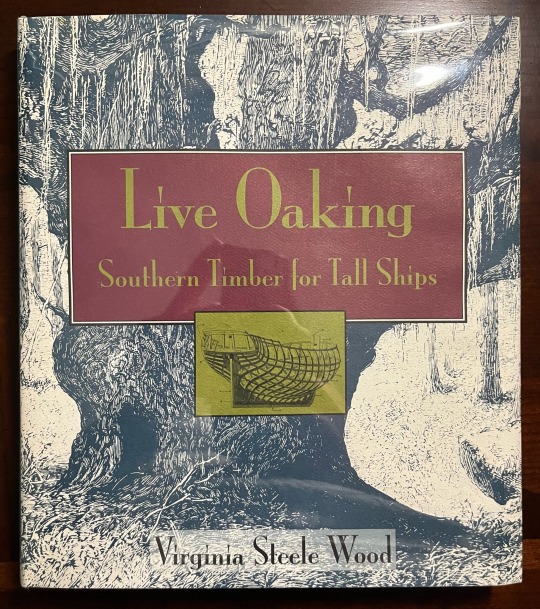
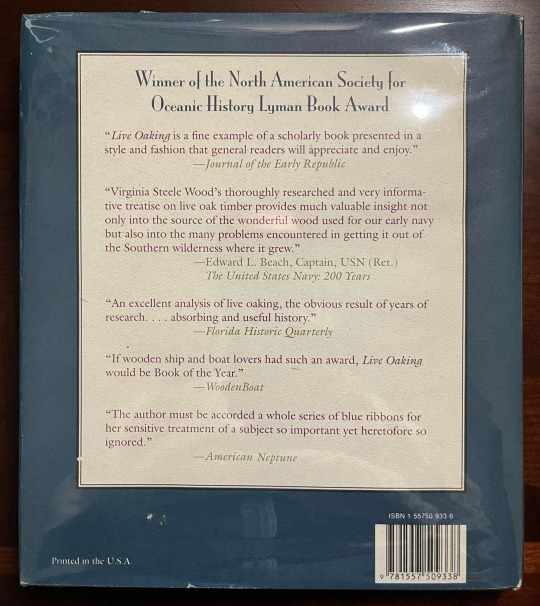

The How
I would say I know, like, a normal amount about wooden ship construction. Sometimes books about such enter one’s awareness and can be had modestly used for modest expense. This isn’t one of those times, though; I paid like $28 for my copy. Sad times.
The Text
So wooden ship construction, right? Calls for great timbers — keels, floors, futtocks of various sorts, stern posts, Sampson posts, bows, knees — among other bits. Live oak is good for those, or was. These days it’s more complicated, but that’s slightly out of scope.
Wood (sensu author) has prepared for us here a good historical account of the live oak trade, and particular live oaking: extraction of the wood (sensu timber) from across southeastern North America, usually by expeditionary crews of shipwrights, carpenters, and slaves. That this is the only real book on the subject — which it is — doesn’t make it good — though it is — but it does make its quirks extra salient.

Quirk #1: Wood (author) uses ‘live oak’ to mean only Quercus virginiana, and implies any other use is a vulgar of the name beyond its proper subject. This is bunk. There are lots of species called the same thing, and I’m not just saying that because I’m a hick. Nor even just because I’m a plant guy, nor from a place with Q. fusiformis as its dominant evergreen oak species, even! Her choice of terms is convenient for the needs of this book, yes, but it’s still bunk.
Quirk #2: Occasionally patriotic? For the needs of this book’s publication, also convenient. Tonally it is bizarre. Apart from two sentences, the book reads as a very straight-laced historical survey. Those spare couple refer to ‘our country’s’ naval power (in the late 18th century) and (of the War of 1812) ‘that regrettable conflict’. I know Warship Guy nostalgia is chronically maladaptive and goofy, but come on.
An interlude here to say the drawings by Walter E. Channing are excellent. He’s the only other author who seems to have treated the subject at all, so appropriate. Warship Guy drafting is chronically clean and good.


Anyway. Quirk #3: The flow of information, while not at all bad, is unpretty. Some ideas and time periods seem to have given themselves easily to thorough research, but others skip by quickly. The later chapters are very thorough indeed, but have very little sense of gravity. The trade in question was vast and the scale of its costs — in labor, in time, in ecological upset — were enormous. This gets lost in the details of daily life that make up the after chapters. The Swift family empire gets a truly good chapter, but that feels like a pet project in a way the others don’t.
Excellent archives work going on here; tons of beautifully relevant original documents have been pulled. The traveling and digging and focus implicated are dumb impressive.

The table to follow is the scariest figure in the whole thing. Hundreds of acres of live oak to build a single 74, and that’s just the frame — no planks, no decks, no rails, no cabins, no masts, no rig, no guns, no furniture, no maintenance — all cut by hand in, say, Georgia or Florida or Louisiana and pulled to, say, Maryland or Massachusetts. Tens of thousands of acres stripped a year for over a century, miles and miles inland from convenient coasts. I wish this did a better job of impressing (ha) that.
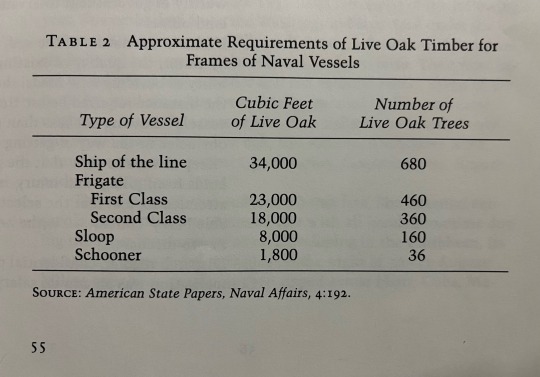
The Object
This copy has suffered somewhat from humidity, but no rough handling. I talk about print quality practically every week, and in this case I can rave. So fucking good. Clean, dark, durable, inert. Scans of period documents are amazing; drawings are amazing. The design work rules. Endpapers are coarse and pleasant. Mentioning Channing’s drawings here again because they’re relevant and I can’t stress enough how legible their spatial aspect is.

The Why, Though?
Having recently moved from [a place with Q. fusiformis as its dominant evergreen oak] to [a place with Q. virginiana as its dominant evergreen oak], the venerable southern live oak is a thing I feel compelled to Know. This is a goofy step toward that, but a step nonetheless.
I’m also excusing this as secret research for a secret project coming down the line sometime between soon and eventually. This contains a song printed (best I can tell, anyway) only once before in 1927, and I wanted it.
28 notes
·
View notes
Text
for those curious here’s a list of the projects i’m currently jumping between at random based on what holds my attention any given hour:
1) manhunt au dnf where gog is part of a team hunting down the library assistant who stole a very important document and dre is a dude with a destiny and they end up getting trapped in a cave together and have to work together to survive
2) royalty au dnf where gog is a spoiled prince and dre is a pompous knight who is hella resentful about being assigned as gog’s personal guard rather than joining the knight swat team, and they fucking hate each other for no good reason until like six weeks of knowing each other when they’re forced to actually Talk
3) cyberpunk au dnf where dre gets trapped in gog’s head on accident and hilarity ensues as gog follows the trail to get to where dre’s body is so he can put him back, but it’s big complicated because dre is technically a cyberterrorist (read: part of a group that opposes the horrible government) and gog is. uh. not exactly an innocent man, to say the least
4) demon au, VERY dead dove don’t eat dnf where gog is a demon that dre signs away his soul to (like i cannot emphasize enough how ridiculously awful this relationship is. it’s so funny. they’re both terrible terrible people)
5) superheroes and villains au using the d$//mp c! characters featuring a Forbidden Ship as a central plot element (which it’s dumb as hell that it’s forbidden because it’s literally fictional characters but people get super weird about it. ugh)
6) massive “sucked into a video game” au featuring sixty creators. the video game they get pulled into doesnt actually exist so i’m going absolutely ham on the worldbuilding. there are curses with debuffs. there are world events. there are dungeons. there are magical artifacts. and everyone gets set to the same “base” physical abilities so gog has a crisis on day 1 because he gets full color vision
i love talking about my own shit so if any of this sounds interesting and you want to know more feel free to drop an ask or w/e and i Will ramble at length. otherwise imma keep picking away and someday post one of these monstrosities
2 notes
·
View notes
Text
Is Java training useful for future generations?
Introduction:
Java is one of the most popular programming languages in the world, and it has been around for over 27 years. Since its creation, Java has become the backbone of many software applications and is widely used in the industry. Java training can be a valuable asset for future generations as it provides a strong foundation for computer programming and software development. In this article, we will discuss the benefits of Java training and how it can prepare future generations for success in the tech industry.
Java is widely used:
Java is one of the most widely used programming languages in the world, and it has become the standard for many software applications. It is used in web development, mobile app development, and enterprise software development. Java is also used in the development of games, e-commerce websites, and many other applications. Therefore, it is a valuable skill for anyone who wants to work in the tech industry.
High demand for Java Developers:
Java Developers are in high demand in the tech industry, and the demand is expected to grow in the future. According to a recent report by the Bureau of Labor Statistics, employment of software developers is projected to grow 22 percent from 2019 to 2029, much faster than the average for all occupations. Therefore, Java training can prepare future generations for lucrative careers in the tech industry.
Java is versatile:
Java is a versatile language that can be used for a wide range of applications. It is used for everything from web development to game development, and it can be used on many different platforms. Java can run on Windows, Mac, Linux, and many other operating systems. This versatility makes Java a valuable skill for anyone who wants to work in the tech industry.
Java is easy to learn:
Java is a relatively easy language to learn, and it is an excellent choice for beginners who want to learn programming. Java has a simple syntax, and it is easy to read and understand. Java is also an object-oriented language, which means that it is organized around objects rather than actions or functions. This makes Java easy to learn and understand.
Java is free:
Java is an open-source language, which means that it is free to use and distribute. This makes Java an excellent choice for anyone who wants to learn programming without investing in expensive software. Java can be downloaded and installed for free, and there are many resources available online for learning Java.
Java is used in education:
Java is used in many educational programs, including computer science courses at universities and coding boot camps. Java is an excellent language for teaching programming concepts because it is easy to learn and understand. Java is also a great language for teaching object-oriented programming, which is an essential concept in software development.
Java has a strong community:
Java has a strong community of developers who are constantly creating new libraries and frameworks. This community is dedicated to improving the language and making it easier to use. This means that there are many resources available for Java developers, including documentation, forums, and open-source projects.
Why Learning Java is Important.
Learning Java is a valuable investment for anyone who wants to pursue a career in the tech industry. Java is a versatile language that is widely used in the development of software applications, and there is a high demand for Java developers. Pursuing a Java course from a reputable institute like Fullstack Guru can provide a strong foundation in Java programming and prepare individuals for success in the tech industry. Fullstack Guru offers the best java classes in Pune taught by experienced instructors who are dedicated to helping students succeed. With hands-on training and real-world projects, Fullstack Guru's Java course provides a practical learning experience that prepares students for a career in software development.
Conclusion:
Java training is a valuable asset for future generations, as it provides a strong foundation for computer programming and software development. Java is a versatile language that is widely used in the tech industry, and there is a high demand for Java developers. Java is also easy to learn and free to use, making it an excellent choice for beginners who want to learn programming. Java is used in many educational programs, and it has a strong community of developers who are dedicated to improving the language. Therefore, Java training is a valuable investment for anyone who wants to work in the tech industry or pursue a career in software development.
3 notes
·
View notes
Text
Learning from Friends: “The Collective School”
The below conversation was published in e-flux Education on March 30, 2023. Thank you, Tyler Considine, for the invitation.
Asia Art Archive (AAA) in Hong Kong recently hosted “The Collective School,” an exhibition and a program series exploring artist-driven and collective models of learning. Developed in collaboration with Gudskul, a Jakarta-based collective that runs a grassroots school for other collectives, the project provokes debates about the necessity and adaptability of collectives today. Amid the growing expectation for art institutions to address social change and learn from collaborative and self-organized initiatives, art collectives have become more relevant than ever. Here, Susanna Chung and Özge Ersoy, two members of the AAA team, discuss the exhibition’s unfolding and what they have learned in the process.
Özge Ersoy: Imagine: You walk out of the elevator onto the eleventh floor of an office building in one of Hong Kong’s old neighborhoods. Through the windows, you first encounter the city’s landscape. Focusing closer, you see a library, with tens of thousands of books nestled among artworks and archival documents about contemporary art collectives. You walk into a spacious reading room and see a large column with hand-drawn graphics highlighting some key values about the current exhibition. You read: knowledge sharing, learning from friends, and collective sustainability.
These concepts have been central to Asia Art Archive’s group discussions with the Jakarta-based Gudskul, our main collaborator for “The Collective School,” and eight other collectives: ba-bau AIR, Hanoi; BiSCA, Bishkek; Load na Dito and Salikhain Kolektib, Quezon City; Omnispace, Bandung; Pangrok Sulap, Sabah; Scutoid Coop, Kaohsiung; and Yayasan Tonjo Foundation, Yogyakarta. 1 Together, we asked: How can we shift the focus of art history from individual artists to communities? How do artists learn from each other outside of formal education and through collectives?
I’ve been excited about our collaboration with Gudskul, especially because they run a grassroots school for other collectives. For us, Gudskul’s model articulates a bold proposition about existing art-educational models: Art schools are often geared toward individual mastery, skill refinement, and career-oriented networking. In contrast, students at Gudskul are already members of existing collectives. They join other collectives to study historical precedents, discuss collective working models, and develop exhibitions and projects together. Eventually participants work as a collective of collectives.
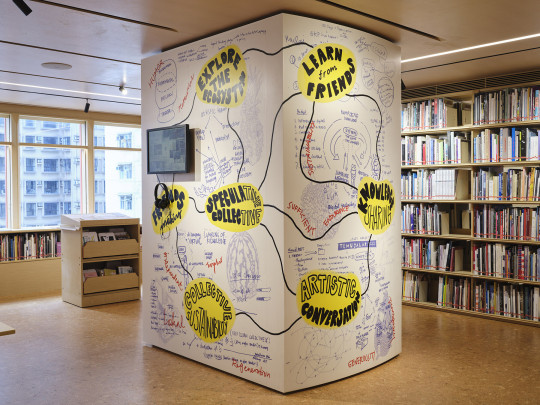
Gudskul, Temu Wall, 2022. Wall graphic with Gudskul, Veranda Talk, video. Installation view, “The Collective School,” CCG Library, Asia Art Archive, October 3, 2022–April 1, 2023. Photo: South Ho.
Susanna Chung: After we invited Gudskul to collaborate on “The Collective School,” they asked us to contribute to their study program. We joined Batch 4, the program’s fourth year, to develop it together with Gudskul and the cohort. While Batch 1 to Batch 3 were held at Gudskul’s campus, where collectives lived and studied together, Batch 4 was held completely online due to the pandemic. Collectives emerge in response to their unique contexts, and while many of them share ideas on the sustainability of collectives and the creation of education platforms, they respond to their contexts with different artistic practices. Becoming more adaptive and responsive to current events, Gudskul engendered new possibilities by connecting beyond Indonesia. As part of this unprecedented Batch, we were able to share and learn about different contexts in which collectivity persists.
Through four seminars, we introduced AAA’s extensive research on art pedagogies in relation to the development of contemporary art across Asia. After sharing case studies from China, India, the Philippines, and Thailand, we invited each collective to focus on one historical collective that most resonated. 2 Those who shared similar interests formed a group, which our researchers joined to exchange ideas, answer questions, and provide materials to inspire the collectives’ artworks. Our team crafted the exhibition narrative and display ideas only after all the works were finalized. All decisions were made in group discussions.
ÖE: The circular model of working diverges from our usual ways of organizing projects, which are often linear and entail a clear division of work. It’s refreshing. I would like to highlight an artwork here: In the middle of the library, we have a one-meter-high fire sculpture made by Quezon City–based collective Load na Dito. It is placed on top of a table covered with the reproduction of a black-and-white photograph depicting a burning action by Xiamen Dada, an art collective known for their radical performances critiquing art institutions in China in the late 1980s. This sculpture is further juxtaposed with a video documentary showing the creation of a four-meter-high effigy for a street demonstration by a group of collectives from Quezon City. Here, Load na Dito proposes the act of burning as a symbol of change and regeneration, a metaphor of collective actions that challenge institutions. By showing their connections with other collectives—both past and present—Load na Dito pays tribute to the legacy of activism of collectives and carries the torch forward.

Load na Dito, Mad in Malacañang, 2022. Video, sculpture, and acrylic on cardboard. Installation view, “The Collective School,” CCG Library, Asia Art Archive, October 3, 2022–April 1, 2023. Photo: South Ho.
SC: Another compelling contribution is one between Pangrok Sulap and Salikhain Kolektib. They both responded to Womanifesto, a feminist art collective and biennial program in Thailand that was most active from the mid-1990s to the mid-2000s.
Pangrok Sulap uses woodcut print as their medium to empower rural communities. Depicting key moments in Womanifesto’s history, their work illustrates the solidarity among women artists and local craftspeople, prompting reflections about the role of artists as custodians of traditional cultural knowledge.
Salikhain Kolektib arranges archival materials about Womanifesto and their own collective chronologically. In the spirit of collaboration, Salikhain Kolektib joined Pangrok Sulap in creating a mirror display box. The mirroring effect melds the two collectives’ works in a fascinating way: the reverse of Pangrok Sulap’s print, featuring a protest for gender equality, can only be seen through Salikhain Kolektib’s artwork. Conversely, the partial reflections of materials through angled mirror slabs disrupt the chronological timeline of the latter’s installation. Rejecting the linearity and singularity of time and place, both collectives’ works invite us to think about sustainability, adaptability, and survival—common foundational concerns of contemporary art collectives.
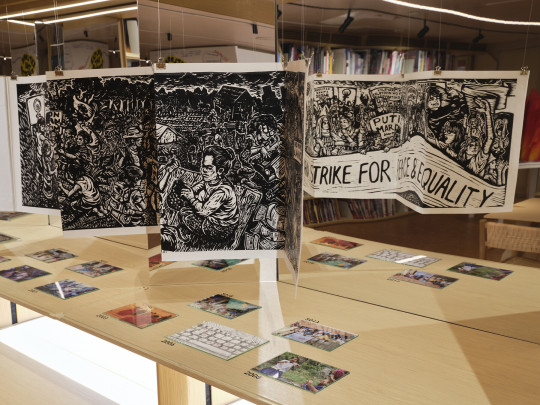
Salikhain Kolektib, Manifesting (In)constancy, 2022. Mixed-media installation; Pangrok Sulap, The Flower of the Nation, 2022. Woodblock print book. Installation view, “The Collective School,” CCG Library, Asia Art Archive, October 3, 2022–April 1, 2023. Photo: South Ho.
ÖE: It’s crucial that Gudskul, Batch 4, and our team discussed not only the potentials of working together but also the challenges and even limitations.
ba-bau AIR created an interactive jenga installation that materializes these conditions. Each hardwood block features terms from three texts related to Black Artists of Asia, a collective that initiated VIVA ExCon in the early 1990s. VIVA ExCon is the longest-running artist-led biennial in the Philippines, and this is another example of a contemporary collective revisiting art-historical documents and art actions in the region from the 1980s and 1990s.
As you begin building with the blocks, free associative readings about resilience and survival emerge. However, a jenga tower will eventually collapse, pointing to the tensions between construction and deconstruction. Yet when we think about the work not as a competition but as a cooperative game, the results become less finite. Your collective work might sometimes feel unstable, but the intention is to keep building together. Even if or when it collapses, other chances of regeneration will emerge.

ba-bau AIR, Building a VIVA ExCon, 2022. Wood blocks. Installation view, “The Collective School,” CCG Library, Asia Art Archive, October 3, 2022–April 1, 2023. Photo: South Ho.
SC: The fluidity of art collectives, as showcased by “The Collective School,” inspires the work we do. An archive is a mobile being, constantly rethinking its positioning and priorities through connecting with artists and collectives.
Their ideas shape our research, programs, and the sites we inhabit. “The Collective School,” for instance, has made us reflect on our long-term interest in pedagogy as a site where modern and contemporary art histories of the region have been written. Beyond the role of art school, this project has also encouraged us to generate new questions about artist-led models of education and alternative pedagogies. Apart from learning in schools, artists also learn from their peers. Collectives can serve as a continuous learning platform for those who have completed art school, as well as those who have not attended art school.
ÖE: One important takeaway from this exploration of how art collectives learn and educate is their insistence on play. It has inspired new programs, such as “Assemblage at AAA,” a durational performance by Hong Kong–based collective Floating Projects. For two days in a row, members brought in found materials as well as items from our library and office and from their own space, and began creating.
I immediately think back to a conversation with Floating Projects, where member Wong Chun-hoi said, “We should be in the same space and play together, instead of talking about what we do and how we do it.”
In the performance, the space of the archive was activated by sharing and collective action. One artist assembled a chess-like game, another few built a sculpture with shredded paper of the collective’s confidential documents, while some others made music and did automatic writing. Anyone in the library was invited to join.
SC: This collective model of learning also helped me rethink our educator programs. Since 2013, we have been organizing the annual Teaching Labs, a professional development series for teachers, each year focusing on a theme that is relevant to contemporary art and education, with this year’s being art collectives.
Working with Gudskul taught me that “art collectives” is not simply a “theme” for study but a model of learning. It inspired me to experiment with a new program, “Knowledge Kitchen,” where ten artists and ten educators gather for six hours each month to engage with creative exercises, games, chats, dinners, and sharing sessions by guest artists. We would like to use this process to practice and experiment with new models of learning. Our goal is to explore how teachers and artists can co-learn, co-create, and co-work together.
Arts programming, like formal education, often transmits knowledge one way; artists or teachers unilaterally impart their knowledge and experience to an audience. This program seeks to cultivate a more open and equal environment for knowledge exchange. We want to link artists’ unique abilities to interpret the world with educators’ intimate understanding of classroom settings. It’s exciting to see what comes out of this. Who knows? Maybe self-organized collaborative projects, lifelong friendships, and more. Our hope is that through this exploration, teachers and artists will reconsider their relationships with students and audiences in various educational and artistic settings, and engage with new imaginations for the future.
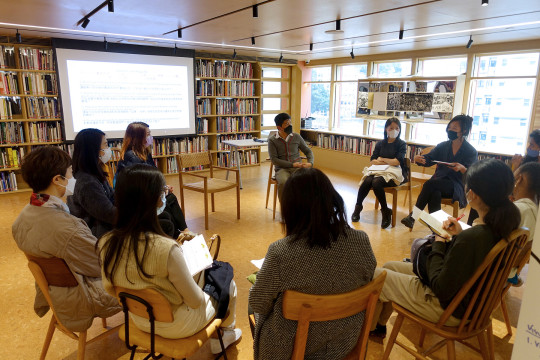
“Teaching Lab: Art between the Individual and the Collective,” Asia Art Archive, February 18, 2023. Courtesy of Asia Art Archive.
ÖE: Yes, we hope to move away from hierarchical ways of knowledge sharing. Apart from “Assemblage at AAA” and “Knowledge Kitchen,” we also hosted a live-streamed cooperative board game called “Speculative Collective.” Rather than inviting Gudskul and the eight collectives to present a talk, we asked them to show us what they cared about through playing. By responding to a series of challenge cards and drafting solutions, they revealed how they approach resource-sharing and collective decision-making. We wanted our audience to engage with—not to be told about—the exhibition.
SC: It’s important to us that this exhibition is the inaugural one of our newly renovated library. We have built a reading room in the center of the library, creating a space for co-working and co-learning, which also serves as a social space for discussion and learning from one another. Working with art collectives across Asia has not only helped us reorient the direction of our programming but has also allowed us to see the necessity and urgency of collectivity here in Hong Kong. We’ve deepened ties with our local partners Floating Projects and Rooftop Institute, whose practices revolve around alternative learning models. This is our first time studying the topic of collectives so closely, and the new library reflects who we are in the spatial sense. Since the beginning, we did not want the library to be a static collection, but rather a place to open up discussion. The study of collectives has made us realize that we share many values with Gudskul, such as learning from friends, engaging in artistic conversations, sharing knowledge, exploring the ecosystem, caring about sustainability, being speculative, and making friends, which are all essential for archive building.
A series of programs at the library resulted from organic discussions with these collectives. In particular, Hong Kong Conversations brought together different generations of artists and cultural workers to discuss historical and contemporary conditions that make collective work necessary in the city. The first talk gathered members from eight Hong Kong collectives founded in the 1990s—Southern Artists Salon, Green Wave Art, The Originals, Epical Chamber, NUX, Community Museum Project, Your Ears Covered, and Kultkuli—followed by three younger collectives—Black Window, Floating Projects, and Popo-Post Art Group. For me, it was a historical moment to see different generations of collectives in the same room, listening to and learning from each other.
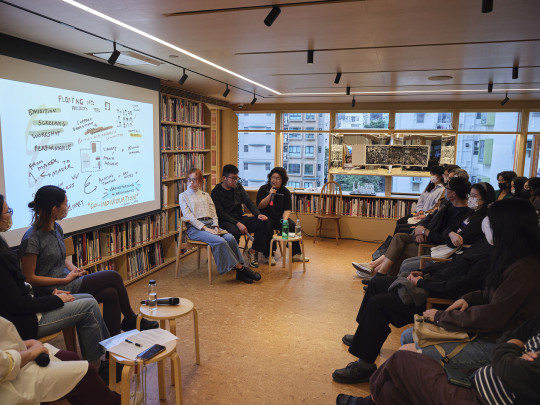
“Hong Kong Conversations 2022: The Collective School,” Asia Art Archive, November 26, 2022. Photo: South Ho.
ÖE: “The Collective School” is an example of how we see archives as social spaces to bring people together, to exchange knowledge, and to connect regional and local contexts. Some consider archives depositories that do not have to interpret or display their holdings. For us, artistic collaborations, including the ones developed from “The Collective School,” are crucial to challenge this view.
Our collaboration with Gudskul and eight other collectives taught me to insist on using exhibitions and programs as research as well as pedagogical tools. The project rearticulates our understanding of art history, one that prioritizes relationships and communities over individuals and singular artworks.
As part of “Assemblage at AAA,” here is an excerpt from the automatic writing of Linda Lai from Floating Projects: “A fresh new library surrounded by chaos and calm before a tempest. Free conversations absolutely free and automatic and without a frame from a handful of frames and many breakable frames.” 3 This is how I would like to imagine our library—a site for artistic intervention and knowledge via the engendering of fragments, play, and free associations, whether they are verbal, sculptural, or textual.
Notes
1. We are also grateful to our local Hong Kong partners Floating Projects and Rooftop Institute.
2. The case studies include the Stars Art Group, Xiamen Dada, and the New Measurement Group in China; Autonomous Women’s Movement in India; Black Artists of Asia in the Philippines; and Womanifesto in Thailand.
3 See →.
2 notes
·
View notes
Text
my favorite groups of patrons to work with at my library are:
weird little girls ages 7-13. (something, something, recognition of self in the other, something) please tell me all about the jellyfish that fascinate you and your new knitting projects and your very specific niche interests. it’s ok if you never, ever want to make eye contact with me. i take zero offense, because like.... i feel the same way. If you want me to look in the other direct while you talk to me, go right ahead. For the autistic little girls i see you friend.
toddlers who are decently well behaved, usually because they are THE funniest people on planet earth. comedians want what 2 year olds have. they are also the most genuine, sweet, completely dead serious people out there. Please show me your scribble that is actually a picture of T-rexes in tutus. (actual picture I was shown by my favorite, now weird little girl gradeschooler, former funniest toddler on the planet O). Other notable littles that I can’t get enough of is the little russian toddler E who comes in with her grandad and they color the same coloring page together and she names out the colors of every crayon she picks from the box out loud as she’s doing it.
little old people. most of them are actually very sweet, or incredibly weird with very fascinating stories to tell you about stuff they did 50 years ago. Also so many of them are befuddled by technology things but they do want to learn! The problem is that SO many young people in their lives brush them off and don’t give them the time and space to learn. The kinds of things that seem self-explanatory to YOU certainly aren’t to them, and they aren’t always the best at articulating WHY they are confused, partially I find because impatient young people have made them feel really embarrassed about the stuff they don’t know. For anyone who is having to teach an old person in your life about tech stuff, you just have to literally imagine that you have never once in your life seen a computer. you’re a time traveler from 1970. They don’t know the difference between left and right click. They’ve never heard the word browser! Give them space and time to explain what they do know before launching yourself. I wrote a 10 step guide with very specific descriptions of everything in the GUI for a little old granny on how to copy and paste text in a word document, and several days later she emailed me to tell me that my guide helped her SO much and that she actually could use copy and paste now. I cried reading that 3 sentence email y’all. validation in this chili’s tonight. The look little old people who finally Get The Thing™ you’re teaching them have on their face in that moment is PRICELESS.
Art Kids™. You want to do art and I want to tell you about art. it’s a win win. Let’s get you some books on cartooning! Please tell me about your latest painting.
Little old grandparents looking to get stuff for their soon to be visiting grankids from out of town. yes we have activities. yes we have toys you can check out and take home. yes we have 30 different recommended book lists. yes we have that book you remember reading to your kids when they were little.
#text#library stuff#sometimes my job sucks but sometimes when i get to work with my favorite patron groups it is SO fulfilling#so like i also have to tell you that talking to little old people is often SO great#because a lot of people get weirder as they get older#and because so many of them would like to tell you long winded stories about stuff that happened 50+ years ago that are usually riveting#also they typically have something weird or interesting they would like to teach you about their Interest™. parallel vibes to weird kids#margaret babbles
3 notes
·
View notes
Text
The Ultimate Guide to PHP Development Companies in the USA
In today's digital age, having a robust online presence is crucial for businesses of all sizes. Whether you're a startup or a Fortune 500 company, having a well-designed website and powerful web applications can set you apart from the competition. This is where PHP development companies come into play. In this comprehensive guide, we'll delve into the world of PHP development companies in the USA, exploring what they offer, how to choose the right one for your needs, and much more.

Understanding PHP Development
PHP, which stands for Hypertext Preprocessor, is a widely-used open-source scripting language that is particularly suited for web development and can be embedded into HTML. It's known for its flexibility, ease of use, and vast community support. PHP development involves creating dynamic web pages, web applications, and e-commerce solutions using PHP.
Benefits of Hiring a PHP Development Company
Hiring a PHP development company can offer numerous advantages. Firstly, you gain access to a team of skilled professionals with expertise in PHP development. These companies often have experience working on a variety of projects, allowing them to tackle challenges efficiently. Additionally, outsourcing PHP development can save you time and resources, enabling you to focus on your core business activities.
Key Factors to Consider
When choosing a PHP development company, there are several factors to consider. These include the company's experience and track record, expertise in relevant technologies, pricing and payment structure, communication channels, and scalability of services. It's essential to thoroughly research and evaluate potential partners to ensure they align with your project requirements and goals.
When considering the future of PHP development, several key factors come into play:
Industry Trends: Keeping abreast of industry trends helps developers anticipate the direction PHP development is heading. This includes staying updated on emerging technologies, popular frameworks, and best practices within the PHP ecosystem.
Performance: Performance is crucial for any web application. Developers should prioritize optimizing PHP code, leveraging caching mechanisms, and choosing efficient frameworks to ensure fast response times and scalability.
Security: With cyber threats constantly evolving, prioritizing security in PHP development is paramount. This involves adopting secure coding practices, regularly updating dependencies, and implementing robust authentication and authorization mechanisms.
Community Support: PHP's vibrant community provides invaluable resources, including documentation, forums, and open-source libraries. Developers should actively engage with the community to share knowledge, seek assistance, and contribute to the collective improvement of PHP development.
Compatibility and Legacy Systems: Many existing applications are built on older versions of PHP. When planning new development or updates, compatibility with legacy systems must be considered to ensure seamless integration and minimal disruption to existing functionality.
Scalability: As applications grow in complexity and user base, scalability becomes a critical factor. PHP developers should design applications with scalability in mind, employing techniques such as distributed architectures, load balancing, and horizontal scaling to handle increased demand.
User Experience (UX): User experience plays a significant role in the success of web applications. PHP developers should focus on creating intuitive interfaces, optimizing performance, and ensuring accessibility to deliver a seamless and engaging user experience.
Emerging Technologies: PHP development doesn't exist in isolation; it intersects with various emerging technologies such as AI, IoT, and blockchain. Developers should explore opportunities to integrate these technologies into PHP applications to enhance functionality and innovation.
Development Tools and Workflow: Streamlining development processes with efficient tools and workflows can greatly improve productivity and code quality. Adopting version control systems, automated testing, and continuous integration/delivery practices can facilitate collaborative development and rapid iteration.
Business Objectives: Ultimately, PHP development should align with the business objectives and requirements of the project. Developers should prioritize features and functionalities that add value to users and contribute to the overall success of the application.
Top PHP Development Companies in the USA
The USA is home to many top-tier PHP development companies known for their quality work and innovative solutions. Some of the notable names in the industry include XYZ Tech, ABC Solutions, and DEF Innovations. These companies have a proven track record of delivering exceptional PHP development services to clients across various industries.
Case Studies
To better understand the capabilities of PHP development companies, let's explore a few case studies. Company X partnered with a PHP development firm to revamp its outdated website, resulting in a 50% increase in online sales. Company Y leveraged PHP development services to build a custom e-commerce platform, leading to improved customer engagement and higher conversion rates.
How to Choose the Right Company
Choosing the right PHP development company can be a daunting task. To make an informed decision, consider factors such as the company's portfolio, client testimonials, communication process, project management approach, and post-launch support. Schedule consultations with potential partners to discuss your project requirements and gauge their responsiveness and expertise.
The Future of PHP Development
As technology continues to evolve, so does PHP development. With the introduction of PHP 8 and advancements in frameworks like Laravel and Symfony, the future looks promising for PHP developers. Additionally, the rise of cloud computing and microservices architecture presents new opportunities for PHP-based web applications to scale and innovate.
The future of PHP development holds a blend of evolution and continuity. Despite the emergence of newer technologies and programming languages, PHP remains a popular choice for web development, powering a significant portion of the internet. Here are some trends and directions shaping its future:
Performance Optimization: PHP frameworks like Laravel and Symfony continue to enhance performance, making PHP applications faster and more efficient. This trend will likely continue with advancements in PHP itself and improvements in server technologies.
Integration with Modern Technologies: PHP is adapting to work seamlessly with modern frontend frameworks like React, Vue.js, and Angular, enabling developers to build powerful, interactive web applications.
Microservices Architecture: As applications grow in complexity, the trend towards microservices architecture continues. PHP, with its ability to build lightweight and scalable services, will play a role in this architecture, especially with frameworks like Lumen.
Serverless Computing: The rise of serverless architecture simplifies deployment and scaling. PHP frameworks are evolving to support serverless deployments, allowing developers to focus on code rather than infrastructure management.
Stronger Typing and Tooling: With the introduction of PHP 7 and later versions, the language has seen significant improvements in typing and tooling support. This trend will likely continue, enhancing code quality, reliability, and developer productivity.
Focus on Security: As cyber threats evolve; PHP developers will prioritize security practices. Frameworks and libraries will continue to integrate features and tools for mitigating security risks, such as SQL injection and cross-site scripting vulnerabilities.
Community and Ecosystem Growth: PHP has a vibrant and active community, continuously contributing to its ecosystem with new libraries, tools, and best practices. This community-driven development will fuel innovation and ensure PHP remains relevant in the future.
AI and Machine Learning Integration: While traditionally not associated with PHP, advancements in AI and machine learning are increasingly becoming accessible to PHP developers through libraries and APIs. This integration will enable the development of intelligent PHP applications.
Graphic Design Integration
In today's visually-driven digital landscape, graphic design plays a crucial role in web development. Many PHP development companies offer graphic design services to complement their development offerings. By integrating stunning visuals, intuitive UI/UX design, and responsive layouts, businesses can create memorable online experiences that resonate with their target audience.

Yii App Development
Yii is a high-performance PHP framework known for its speed, security, and extensibility. PHP development companies specializing in Yii app development can create scalable and feature-rich web applications tailored to your specific requirements. Whether you're building a social networking platform, an e-commerce marketplace, or a content management system, Yii offers the flexibility and efficiency needed to bring your ideas to life.
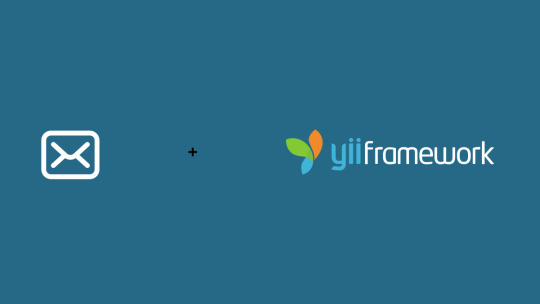
Conclusion:
In conclusion, PHP development companies play a crucial role in building robust, scalable, and secure web solutions for businesses in the USA and beyond. By understanding the key factors to consider, exploring case studies, and leveraging graphic design and Yii app development, you can make informed decisions when selecting the right partner for your PHP development needs.
0 notes
Text
Best PHP training institute in rajkot , top PHP training institute in rajkot
If you looking for best PHP training institute we are here
Devweb Technoogy is provide professional training we have 12 + year experience in this filed , we also provide live projecting training with certificate .
PHP, which stands for Hypertext Preprocessor, is a widely-used open-source scripting language that is especially suited for web development and can be embedded into HTML. It is commonly used to create dynamic web pages and server-side scripting.
Here are some key features and aspects of PHP:
dynamic content generation and interaction with databases and other server-side resources.
Integration with HTML: PHP code can be embedded directly into HTML, allowing developers to mix PHP and HTML seamlessly within the same file, making it easy to create dynamic web pages.
Database Connectivity: PHP provides built-in support for connecting to various databases, such as MySQL, PostgreSQL, SQLite, and more. This makes it a popular choice for building database-driven web applications.
Extensive Library Support: PHP has a vast ecosystem of libraries and frameworks that provide pre-built solutions for common web development tasks, such as user authentication, form validation, session management, and more. Some popular PHP frameworks include Laravel, Symfony, CodeIgniter, and Yii.
Platform Independence: PHP is platform-independent, meaning it can run on various operating systems like Windows, Linux, macOS, etc. This makes it highly flexible and suitable for a wide range of hosting environments.
Community Support: PHP has a large and active community of developers who contribute to its development, create libraries and frameworks, and provide support through online forums, tutorials, and documentation.
Ease of Learning: PHP is known for its simplicity and ease of learning, especially for beginners in web development. Its syntax is similar to other programming languages like C and JavaScript, making it accessible to a wide audience.
Overall, PHP is a powerful and versatile language for building dynamic web applications, ranging from simple websites to complex web platforms and e-commerce systems. Its combination of flexibility, ease of use, and extensive features has made it one of the most popular choices for web development over the years. read more
#php#phptraining#phptraininginstituteinrajkot#bestphptraininginstituteinrajkot#devwebtechnologyrajkot#topphptraininginstituteinrajkot
0 notes
Text
Elevate Your Python Skills: A Detailed Guide to Becoming Proficient
Python is a versatile and widely-used programming language that powers everything from web applications to data analysis. Whether you're a novice or an experienced developer, there are always ways to enhance your Python skills. Considering the kind support of Learn Python Course in Hyderabad, Whatever your level of experience or reason for switching from another programming language, learning Python gets much more fun.
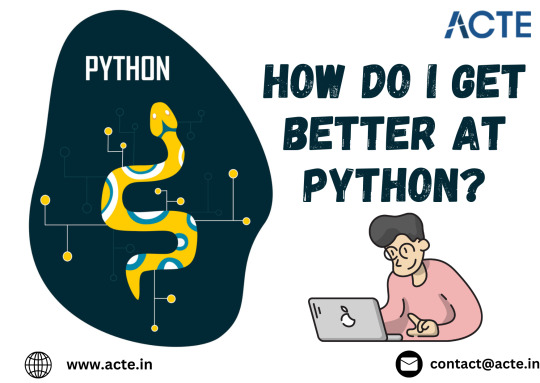
This guide provides a strategic approach to mastering Python and advancing your programming abilities.
Laying a Strong Foundation
Before tackling complex topics, it’s crucial to have a solid grasp of Python basics. Start with understanding the fundamental syntax, data types, control structures, functions, and error handling. Numerous resources are available to help you get started. Online platforms such as Codecademy, Coursera, and Udemy offer comprehensive beginner courses. Books like "Python Crash Course" by Eric Matthes and "Automate the Boring Stuff with Python" by Al Sweigart are excellent for foundational learning. Additionally, Python’s official documentation is a great resource for understanding the language’s features and libraries.
Consistent Practice
The key to mastering Python is consistent practice. Make coding a daily or weekly habit to reinforce your learning and improve your skills. Regular practice solidifies your understanding and enhances your problem-solving abilities. Websites like LeetCode, HackerRank, and CodeSignal provide a wide range of coding challenges that cater to different skill levels, offering an excellent way to practice and apply your knowledge.
Building Practical Projects
One of the most effective ways to learn Python is by working on real-world projects. Projects help you understand code structure, debugging, and problem-solving in practical scenarios. Start with simple projects, like creating a to-do list app, a web scraper, or a basic calculator. As you gain confidence, move on to more complex projects such as a personal finance tracker, a blog using Django, or a weather forecasting app. Eventually, challenge yourself with advanced projects like developing machine learning models, RESTful APIs, or e-commerce websites.
Diving into Books and Documentation
Beyond courses and tutorials, reading books can provide deeper insights into Python. For beginners, "Automate the Boring Stuff with Python" by Al Sweigart and "Python Crash Course" by Eric Matthes are excellent resources. For advanced learners, "Fluent Python" by Luciano Ramalho and "Effective Python" by Brett Slatkin offer valuable knowledge. Regularly reading Python’s official documentation keeps you updated with the language’s capabilities and standard libraries. Enrolling in the Best Python Certification Online can help people realise Python's full potential and gain a deeper understanding of its complexities.

Engaging with the Community
Joining Python communities and forums is a great way to learn, share knowledge, and stay motivated. Participate in discussions on the Python subreddit, Stack Overflow, or specialized forums like Real Python. Attend local Python meetups or join user groups to network with other developers and gain insights from their experiences. Additionally, attending Python conferences like PyCon can provide exposure to industry experts and hands-on workshops.
Learning from Others’ Code
Studying code written by experienced developers can introduce you to new techniques and best practices. Explore well-documented repositories on GitHub to see how others solve problems and structure their code. This practice can inspire you and help you improve your coding style and efficiency.
Exploring Advanced Topics
After mastering the basics, delve into more advanced Python topics. This includes studying algorithms and data structures, understanding object-oriented programming, and exploring specialized fields like web development, data science, and machine learning. Learn common algorithms and data structures such as sorting algorithms, linked lists, and binary trees. Understand the principles of object-oriented programming, including classes, inheritance, and polymorphism. Explore frameworks like Django and Flask for web development. Use libraries like Pandas, NumPy, and Scikit-Learn to analyze data and build machine learning models.
Participating in Competitions
Coding competitions are a fun and challenging way to test your skills and learn new techniques. Platforms like Kaggle, Codewars, and Google Code Jam offer unique problems that require innovative solutions. Kaggle focuses on data science and machine learning competitions. Codewars provides a variety of coding challenges to sharpen your problem-solving skills. Google Code Jam presents complex algorithmic problems that push your coding abilities to the limit.
Continuous Learning Through Courses
Staying updated and enhancing your skills requires ongoing education. Enroll in advanced courses on platforms like Coursera, Udacity, edX, or Pluralsight. These platforms offer specialized tracks in areas such as data science, web development, and artificial intelligence, allowing you to tailor your learning to your career goals.
Review and Improve
Regularly reviewing your own code and projects is essential for growth. Refactor your code to make it cleaner and more efficient. Seek feedback from peers to gain different perspectives. Continuous reflection and iteration on your work is crucial for long-term improvement.
Conclusion
Mastering Python is a continuous journey of learning and practice. By following these strategies and staying committed to your growth, you can become proficient and confident in your Python programming abilities. Start today, maintain your curiosity, and keep challenging yourself to unlock the full potential of Python.
0 notes